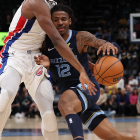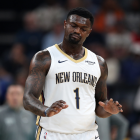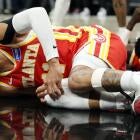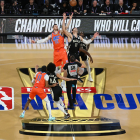
Ja Morant doesn't want his minutes messed with, but his declining production no longer warrants superstar say
Girzzlies coach Tuomas Iisalo provided great perspective on Morant's sort-of new rotation pattern

Ja Morant returned on Monday from his one-game suspension for conduct detrimental to the team (coach Tuomas Iisalo reportedly called out Morant's lack of leadership and general on-court effort after Memphis' loss to the Lakers, in front of the team, and the superstar didn't respond so kindly), and his first comments didn't exactly paint a portrait of reconciliation.
Asked if he currently has the same "joy" for the game that he used to have, Morant simply said "no." The rest of the exchange with reporters was the palpable embodiment of passive-aggressive tension.
Ja Morant regarding what happened Friday and the suspension.
— Matt Infield (@Matt_Infield) November 4, 2025
On if things have been resolved: "Yeah, they (Tuomas Iisalo) told y'all that right?"
Also says "If I didn't have a good relationship, I wouldn't talk to them at all" regarding his relationship with the franchise. pic.twitter.com/BaoNz7gTOp
It begs the question: What is Morant so upset about? According to ESPN's Shams Charania, at least one the issues, from Morant's vantage point, is Iisalo's "rotation patterns." This is no small matter. Superstars have their rhythms and they don't like them messed with, and beginning last season, when Iisalo was on Memphis' staff, the Grizzlies began deploying Morant in shorter stints of playing time.
Go back to 2022-23, when Morant looked like he was on an MVP trajectory, and you'll see him playing basically the entire first and third quarters with one extended break to begin the second and fourth quarters before re-entering for the last six minutes of each half.
On Monday, just as an example, he came out at the 6:19 mark of the first quarter and went back in at the 3:14 mark. In the second quarter, he came out at the 8:36 mark and went back in with 5:41 to play in the half. Do the math, and he's playing for about 5-6 minute stretches before getting about a three-minute break.
So each stint of playing time is shorter, and so are the rest periods. You can see how this could potentially mess with the rhythms of certain players, to be in and out more frequently and not have as much time over any one stint to work yourself into full rhythm. But there are two schools of thought here, and Iisalo broke the mechanics of the decision down, from the team's perspective, in great detail on Monday.
"I have a lot of understanding for the players who say this," Iisalo said of the pushback some guys have in terms of more frequently interrupted playing time. "A lot of players have been conditioned throughout their career to play in longer stints and go find that rhythm, and basketball, just like every other global team invasion sport, is evolving, and the demands on the intensity are higher and higher. And we are looking to also adapt to the times.
"A lot of planning, a lot of feel, goes into planning the sub patterns. I think what's often forgotten is what comes out [of] the actual sub pattern, it's to optimize results in the short, medium and long term. That is the only goal of the sub pattern, to find a competitive advantage from it."
The reported tension between Ja Morant and Tuomas Iisalo came from Iisalo's sub patterns, prioritizing shorter, more intense stints.
— Matt Infield (@Matt_Infield) November 3, 2025
Iisalo was asked about the concerns players may have about that taking them out of rhythm, gave a great answer to his thought process
⬇️ pic.twitter.com/1eEEN8AbV2
If you watched the whole video, you know that Iisalo went on to address the opposite side of the coin, the side Morant would seemingly rather play, by acknowledging the risk of compromised rhythm in shorter stints of playing time -- not just for the individual but the lineups as a whole that are trying to build chemistry through repetition. So it's not as if this is being implemented blindly or without great consideration.
But in Iisalo's and the Grizzlies' view, for now at least, the point about the greater intensity demands put on each player in today's game trumps the other concerns. The game is played at such a fast pace these days (the Grizzlies are No. 7 in pace), and with everyone on the court being able to shoot, the space each player has to cover has risen dramatically as well. All of which is to sat, it stands to reason you're going to fatigue faster, and if you continue to play through that fatigue, decreased production, injury risk, all of these things become logical concerns.
Hockey has always operated on this logic. Even the best players play in extremely short stints, because for the time they're out there they are going full blast. Not only does this allow a player like Morant, who relies so heavily on beating defenders off the dribble and outrunning everyone on the court, to be at his freshest, but it also potentially allows for the opportunity to play against opposing superstars who are not on similar sub patterns and might be at the end of their energy tank when Morant re-enters after an oxygen fill up.
There's not necessarily a right or wrong answer here. If there was, every team would use the same rotation patterns with their stars. It's a balance of what the team feels the data tells them and what best suits the player's preferences. Morant probably believes he has earned the right to control his own minutes, but it must be said that Morant is not the superstar player that he used to be.
In other words, if you're Luka Doncic, Nikola Jokic, Shai Gilgeous-Alexander, Giannis Antetokounmpo, or any of the other handful of true superstars in today's NBA, you might get final say on these matters. But if you're Ja Morant, for reasons of pure-and-simple production that we're about to address, you simply don't have that level of influence.
After a 5-for-15 showing, including 0 of 4 from 3, in Memphis' loss to Detroit on Monday, Morant is shooting 13.8% from 3 (5 for 36) and just 39% overall to start the season. He's never been a good shooter, but for a minute it looked like he was trending toward competency -- at least if you allowed him to walk into practice shots. That hasn't been the case for a while, nor has the idea that his consistent ability to get to the rim and finish with world-class force and athleticism adequately covers for what has become, without question, the single-worst defect a point guard can have in today's game.
Concerning trend for Ja Morant: https://t.co/ThKJVu8Mxc pic.twitter.com/3LgJh65W3m
— Kevin O'Connor (@KevinOConnor) November 1, 2025
For those of you unfamiliar with what these numbers mean, "at-rim frequency" represents the percentage of Morant's total shots that care coming, or in years past have come, from inside the restricted area (four feet). You can see that when Morant was in his "this guy is a future MVP" prime, basically half his attempts came at the rim, but that number has steadily declined to an even lower mark than the one charted in the above graph (it was actually at 25% entering play on Monday, per Cleaning the Glass).
Meanwhile, entering play on Monday, 37% of Morant's shots this season had come from either the long mid-range (between 15 feet and the 3-point line) or beyond the arc, per CTG, by far a cumulative career high. Which is to say, a terrible outside shooter is taking more outside shots than ever, a development in keeping with a half-decade trend that has unsurprisingly correlated with an across-the-board decline in everything from paint points to PER and on down the metrical line.
| Season | Points per game | Paint points per game | Free throw rate | PER | Win Shares per 48 | Box Plus-Minus |
|---|---|---|---|---|---|---|
'21-22 | 27.4 | 16.6 | 35.3% | 24.4 | .171 | 6.1 |
'22-23 | 26.2 | 14.4 | 40.9% | 23.3 | .148 | 5.7 |
'23-24 | 25.1 | 13.8 | 37.6% | 20.6 | .124 | 3.1 |
'24-25 | 23.2 | 11.4 | 35.9% | 19.3 | .112 | 2.4 |
'25-26 | 20.4 | 11.3 | 33% | 17.5 | .046 | -2.7 |
Obviously, this adds a major layer to the Morant saga in Memphis. The Grizzlies are trying to get him back to the guy who is attacking non-stop downhill and living in the paint and at the rim, and they clearly think having him at higher output capacity for more of his minutes, even at the potential expense of extended rhythm, is a worthwhile tradeoff.
Maybe they're wrong. But in the end, even at the professional level, coaches get to make the final call on these things. It may lead to the coach being fired (which Taylor Jenkins knows all too well as he was fired with nine games to play last season after reported frustration on Morant's part regarding the offense that had gone away from the point guard's preferred pick-and-roll emphasis), or the player being traded, but until one of those things happens, this isn't, ultimately, Morant's call.
Either way, this does not seem to situation headed for a make-the-peace ending. Typically, when an NBA superstar (which Morant still believes he is and may very well still be capable of being) digs in like this, the bridge back to common ground has been burned. Do not be surprised if Morant's name is being mentioned in trade rumors in the coming weeks.


















